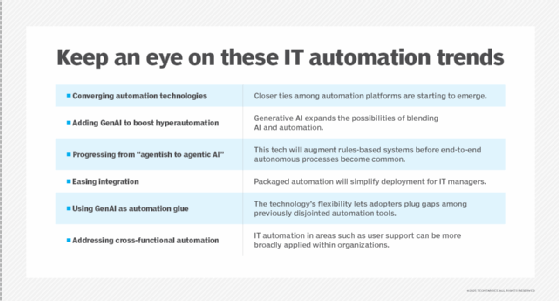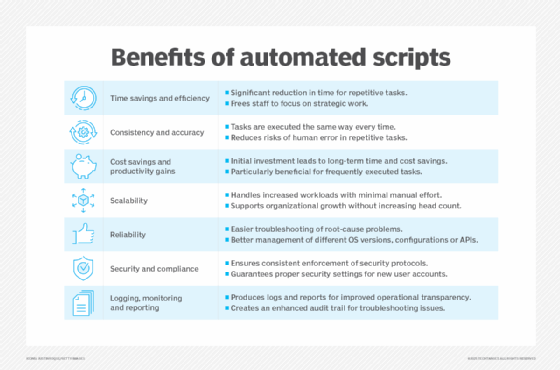What is an automated script?
An automated script is a code snippet that executes repetitive or complex tasks, such as provisioning infrastructure, managing security vulnerabilities, setting up data pipelines and testing software, with little or no human intervention. The scripts are often written in Python, Bash or PowerShell.
Simple automated scripts might execute a few system commands. More complex ones might weave together multiple scripts to support process automation across an orchestration framework, a continuous integration/continuous deployment (CI/CD) tool or a data integration pipeline.
Once written and configured, automated scripts run the same way every time without requiring manual intervention at each step, making them valuable for IT process improvement and business agility. However, other approaches are required for flexibility and to overcome automated script support gaps.
How do automation scripts work?
Automation scripts operate by programmatically performing actions that a human might otherwise perform manually. An interpreter or runtime environment system reads the script's code and carries out the instructions line by line. This differs from compiled software, since the scripts are generally interpreted on the fly, making it easier to troubleshoot problems in development. This lets teams write and modify scripts for various automation needs.
Underneath the surface, automation scripts interact with operating systems (OSes), software apps and other services through command-line commands, API calls and programmatic interfaces. A script might tell an OS to copy a set of files, check system settings or send an alert if a threshold is exceeded. It can also include logic that supports if-then statements, loops and error handling to make decisions during execution. This provides a framework to capture procedural knowledge in code form. However, this also means that scripts lack the flexibility to adapt to unknown situations. Thus, they are typically only used for well-defined tasks with predictable steps.
Automated scripts can be launched in various ways, including being called by a user or a schedule, in response to an event or when exceeding predefined system thresholds. For example, a cron job on a Linux server might run every night at 2 a.m., or an event monitoring system might trigger a remediation script when a threshold is exceeded. Scripting infrastructure is often baked into other automation frameworks for IT job schedulers, DevOps pipelines and robotic process automation (RPA) platforms that orchestrate where and how scripts are run as part of a broader process.
An automated script executes many of the tasks a human or administrator can perform, but faster and more consistently with the appropriate permissions, context and supporting infrastructure. At the system level, they can automate OS commands to manage files, monitor system health and update configurations. They can query databases, invoke APIs or control behavior at the app level. At the enterprise software level, they can automate many tasks that might require clicking through multiple graphical user interfaces.
Automated scripts often start as small tactical solutions to a particular task. Over time, a library of scripts can grow to support various facets of a complete process. IT administrators should look at an individual script as a first step while considering how this might be managed and used over time through documentation, integration into a centralized automation system and management using infrastructure-as-code tools.
Traditional automation script approaches could only do what they were explicitly programmed to do. Modern script automation frameworks can provide a framework to execute scripts more adaptively, such as when a file path changes within limits. However, these tools might struggle when environments scale and tasks grow more complex, and processes might require the careful orchestration of many scripts.

What scripting languages are used for automation?
Various scripting and programming languages are used to write automation scripts. Each language has its strengths, ideal use cases and required skills. Interpreted languages such as Python, Bash, JavaScript and PowerShell execute scripts on the fly, streamlining human understanding and troubleshooting. Compiled languages such as C++ and Rust are sometimes used for writing automated scripts to improve performance, but they are harder to understand and modify after the fact. The following is a list of common scripting languages used today:
- Bash. This scripting language for Unix and Linux environments automates server and workstation tasks. It can call native OS commands to manage files, processes and services. For example, Bash might automate deployments, backups, log rotations and other workflows that require executing a sequence of command-line operations.
- PowerShell. PowerShell is comparable to Bash, but it's for Windows servers and clients. It can automate OS commands and call Microsoft .NET framework services to manage the Windows registry, Active Directory and Azure Cloud resources. In IT process automation, it can create user accounts, configure Windows servers and automate patches.
- Python. This is a more generic interpretive language for automation across many domains. Python is frequently used to automate tasks supporting data processing, file manipulation, API integration, infrastructure provisioning and test automation. It excels in data processing pipeline automation thanks to widespread Python support across data engineering tools that gather, clean and analyze data.
- JavaScript. This programming language started with a focus on client-side apps. However, Node.js extended its utility to general-purpose scripting, particularly in web-related applications. JavaScript is widely used to automate website interactions for data scraping and test automation.
Other languages sometimes used to write automated scripts include Java, Groovy -- an open source scripting language for the Java platform -- Ruby, PHP, Go and Rust. In addition, cloud providers, automation tool vendors and enterprise software vendors provide numerous other variants of these common languages designed to improve performance and control on their respective platforms.
8 steps to create an automation script
There are many ways to create a useful automation script. In the simplest case, a knowledgeable programmer or IT expert might create a script to automate a time-consuming and often-repeated task. These simple scripts might solve a pressing problem, but they might suffer security, performance, maintenance or flexibility issues that limit their value in the long run.
A more systemic approach takes a bit more time to plan, build, test and maintain an integrated and managed script library. This requires more work on the front end, but it can improve reusability, management and extensibility. Let's walk through how this might look in practice.
Step 1: Define objectives and requirements
The team identifies the manual process they want to replace and then gathers requirements and success criteria for the automation. For example, what triggers the task? What system or applications will be touched? How will it streamline the process? What security and issues need to be addressed?
Step 2: Select the right tool and scripting language
Different scenarios require different tools. A Linux automation might prioritize Bash, a Windows automation might prioritize PowerShell, and a data project might prioritize Python. It's also important to keep developer expertise in mind.
Step 3: Break the task into steps
Reframe the core problem as a sequence of steps that map to the chosen programming language. This ensures sub-steps aren't overlooked and makes implementing and debugging the script easier. In IT scenarios, this might include ensuring each command or API call is identified. In business process scenarios, this might involve mapping out business process flows or decision points.
Step 4: Set up the environment
The team needs to set up, configure and document the environment where the automated script will run. This could include OS, API and software versions. This is critical because it ensures the script will run consistently. If one of these versions changes later, it will be easier to update the script or roll back the update, depending on which is easier or more important.
Step 5: Write the script
A developer or IT pro writing a simple use case script for themselves might start with this step, since they can fix any errors that appear later on. However, the work in the previous steps creates the foundation for automated scripts that might be more performant, flexible, secure and manageable across the organization and over time. More sustainable scripts require thinking through failure modes, error handling and logging, and mechanisms to ensure the script functions as intended, despite problems.
Step 6: Testing
Does the script work as intended? Does it work with edge cases? How does it handle problems with the infrastructure, apps or other conditions? How can these issues be logged and presented to users running the script or the IT experts tasked with fixing problems?
Step 7: Documentation
It's important to explain the script's purpose, use cases and limitations for others considering using it independently or as part of a larger process. This ensures that others use the script for its intended purpose rather than trying to troubleshoot problems with a script that has been applied to problems it's not suited for. Documentation can also help troubleshoot problems when scripts don't deliver the desired result, corrupt data or break other things.
Step 8: Monitor and maintain
Scripts should be tracked to assess whether they perform as intended; do not result in unexpected security, privacy or performance issues; and function with new versions of OSes, apps or APIs. Scripts in critical workflows must be treated like any other important piece of software using version control, change management and continuous improvement efforts. It might make sense to refactor an important script for improved performance, as well as better integration or error handling.

What are the benefits of automation scripts?
Replacing manual work with scripted automation can improve speed, accuracy and costs. Here are some of the key benefits to IT operations and the business:
- Time savings and efficiency. An immediate benefit of script automation is a significant reduction in the time required to complete repetitive tasks. A good script can perform in seconds or minutes what might take hours for a human to do. This frees staff to support more strategic or contextual work.
- Consistency and accuracy. Scripts execute tasks the same way every time, ensuring high consistency. This reduces the risks of people accidentally hitting the wrong key or clicking the wrong button during repetitive tasks. This is crucial for tasks such as configuration changes and data entry, where a small error could have serious consequences.
- Cost savings and productivity gains. Although there is some investment of time and money in developing scripts, individuals and organizations can save significantly more time in the long run, particularly for frequently executed tasks and processes.
- Scalability. A script can scale up to handle increased workloads with minimal manual effort. This enables organizations to grow some operations without increasing head count to support them.
- Reliability. Well-documented scripts make it easier to troubleshoot root-cause problems when they occur -- particularly when they arise from different versions of OSes, configurations or APIs supporting the script.
- Security and compliance. Unlike a human who forgot a step that exposes data, scripts make it easier to enforce security protocols and checks consistently. For example, an automated script can guarantee every new user account has the proper security settings or that system patches are applied promptly.
- Logging, monitoring and reporting. Automation scripts can be configured to produce logs and reports to improve transparency into operations. Humans might forget important details about what they did or the specific nature of the problem that arose during a task. The enhanced audit trail associated with automated scripts can help troubleshoot problems when things go wrong.
Examples of automation scripts
Automation scripts are used in various IT and business processes. Here are some examples of how automation scripts can help to streamline and improve the management of different kinds of processes:
- System maintenance and IT operations. A script could monitor disk space and automatically send an email alert to system administrators when a particular disk exceeds a safe margin. This script might run regularly as a cron job, check disk utilization and send an email when the free capacity exceeds a threshold. This removes the need for a human to constantly watch the system.
- DevOps and deployment pipelines. A deployment pipeline might include a script that compiles code, runs test suites, provisions and configures the environment, and then deploys the update. In this case, the process might be executed by a Jenkins pipeline or GitHub Actions script that defines each step.
- Test automation. Modern test-driven development practices encourage developers to start by coding a test to help understand the specific requirements of new code earlier in the process. Ideally, this process could use previously written automation scripts to determine how new code might create problems for the existing infrastructure. Developers might also need to develop new automation scripts to ensure the new code's functionality.
- Data processing, reporting and AI. Script automation can help ensure consistency in how data is ingested, cleaned, transformed and processed when used over time for the same process or across different processes. For example, a Python script could read the raw data; filter, transform and clean it; and then consistently stage it for further processing, reporting or AI applications.
These examples provide a very broad overview of an automated script. Virtually any repetitive or logically defined process can be automated within the capabilities of the supporting OS, API or application. The landscape of supporting tools is also changing. For example, new agentic AI tools might help reconfigure automation scripts to improve flexibility or connect processes across multiple disparate scripts, RPA bots or existing application workflows.








